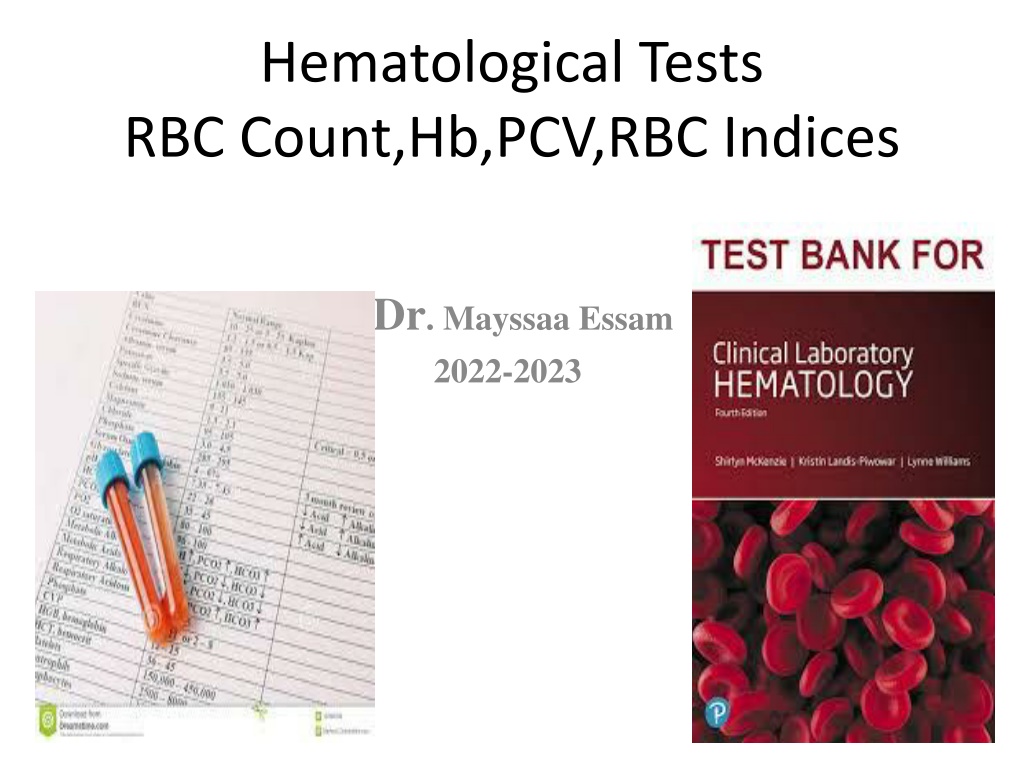Understanding Hemoglobin Tests and Hematocrit in Blood Analysis
A hemoglobin test measures the amount of hemoglobin in the blood, which is essential for oxygen transportation in red blood cells. The test is crucial for diagnosing various health conditions, and visual methods are employed for analysis. Additionally, hematocrit, or red blood cell volume, is another key indicator evaluated in blood tests. Knowing the reference ranges for different groups helps in interpreting the results effectively.
Download Presentation

Please find below an Image/Link to download the presentation.
The content on the website is provided AS IS for your information and personal use only. It may not be sold, licensed, or shared on other websites without obtaining consent from the author. Download presentation by click this link. If you encounter any issues during the download, it is possible that the publisher has removed the file from their server.
E N D
Presentation Transcript
Hematological Tests RBC Count,Hb,PCV,RBC Indices Dr. Mayssaa Essam 2022-2023
What Is a Hemoglobin Test? A hemoglobin test measures the amount of hemoglobin (Hb or Hgb) in your blood. This protein in your red blood cells (RBCs) carries oxygen and carbon dioxide between the lungs and the rest of the body. An altered hemoglobin level is often a sign of disease. Without the right amount, your body may not have enough energy to function optimally. A blood test that measures hemoglobin is part of a routine check-up. Your healthcare providers might also order a hemoglobin test for you if they are interested about your health.
Photometric Technique The absorbance of hemoglobin in a blood sample is measured electronically by a colorimeter or different analyzers. Ways of measuring include many techniques
Visual methods include: Tallqvist or WHO Colour Scale (filter paper). Sahli method (acid haematin). Lovibond comparator (oxyhaemoglobin). Grey wedge (Spencer method or BMS photometer). In the visual methods, the observer matches the colour of the sample against a series of standards, either directly or after adding a chemical or lysing agent to the blood. These methods are subjective, that is, the results depend on the opinion of the observer. Therefore these methods are not recommended.
Sample Hemoglobin Level Reference Ranges For Approximate Range Women 12.0 to 15.5 gm/dl Men 13.5 to 17.5 gm/dl Children 11 to 16 g/dl Pregnant Women 11 to 12 g/dl
The percentage of the volume of blood occupied by the red cells constitutes hematocrit or packed cell volume. Hct % = {Height of RBCs (mm) / Height of RBCs and plasma (mm)} 100 For example, if the height of packed red cells is 45 mm, then = 45/ 100 100 = 45 percent. It also means that out of 100 volumes (or parts) of blood 45 volumes (or parts) are red cells and 55 volumes (or parts) are plasma. Thus, out of 1 liter of blood, 450 ml are red cells and 550 ml are plasma.
Red blood cell indices (measurements) RBC are also known as erythrocytes or red blood corpuscles as it contains *haemoglobin which turns red on binding with oxygen. *It also carries carbon dioxide away from tissues to lungs. *It contains certain antigens on its surface membrane that determine blood groups and makes basis of whole blood transfusion physiology. Shape - Normal biconcave disc. Biconcave shape has many advantages: 1. Flexibility RBCs 2. Greater surface area/volume ratio
Red Blood Cells- Normal values RBCs Count-4-6 million/mm 3 Hb content-14-16 gm/dl. O carrying Capacity of blood-1 gm Hb binds to 1.34 ml of O . PCV=45 2 ml/100 ml of blood. Red blood cell indices are blood tests that provide information about the average volume or size (MCV) and hemoglobin content (MCH, MCHC) of red blood cell.
Mean corpuscular volume (MCV) is the average volume of a single RBC. We need values of: RBC count PCV = PCV X 10 /RBCs = 80-100 Mean corpuscular hemoglobin (MCH) is the average amount of hemoglobin of a single RBC. We need values of: RBC count Hb = Hb X 10 pg RBCs = 27-32 pg
Mean corpuscular hemoglobin Concentration (MCHC) is the average concentration of hemoglobin per unit volume of RBC. We need values of: PCV Hb = Hb X 100 g PCV =32-36 %


























